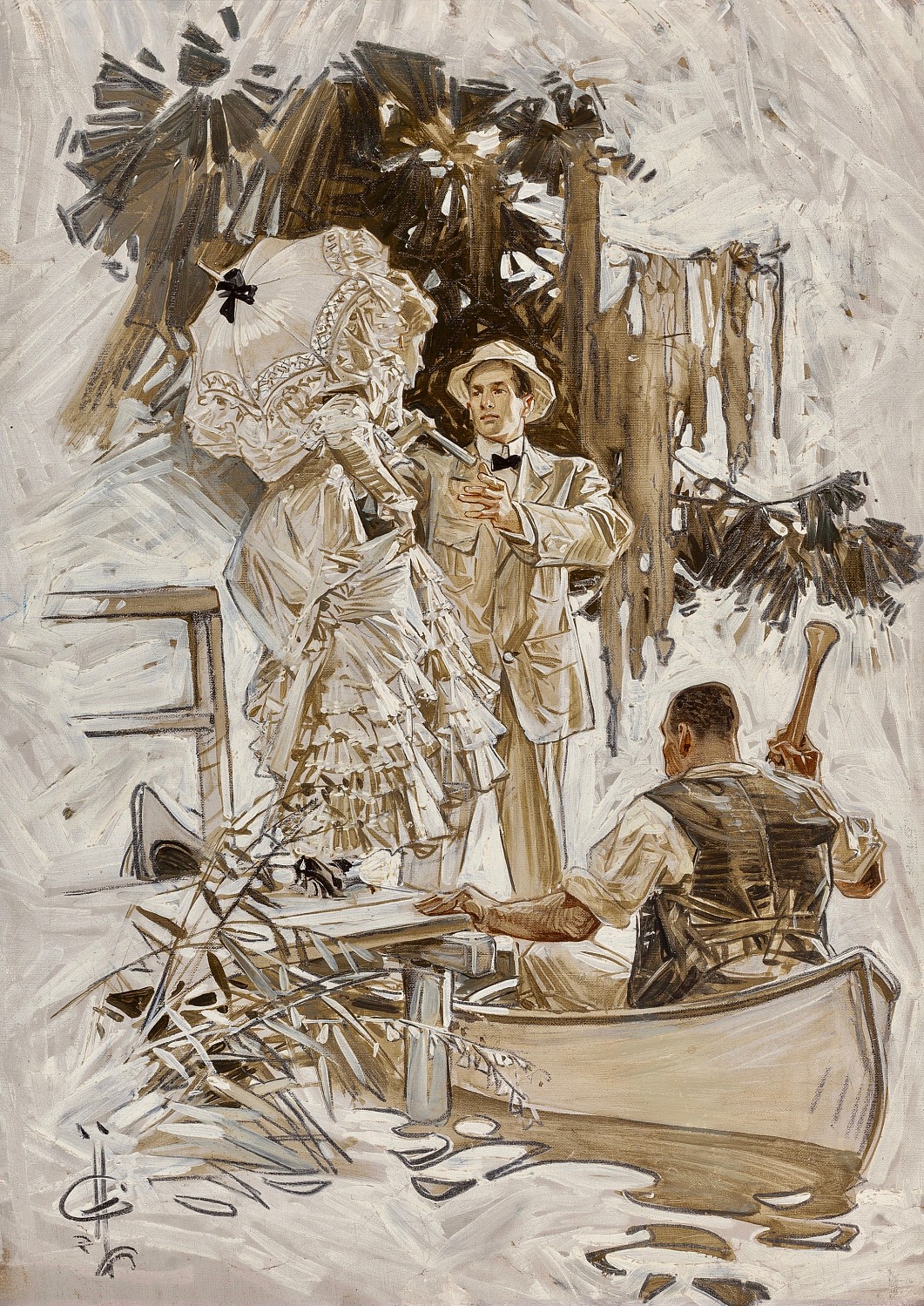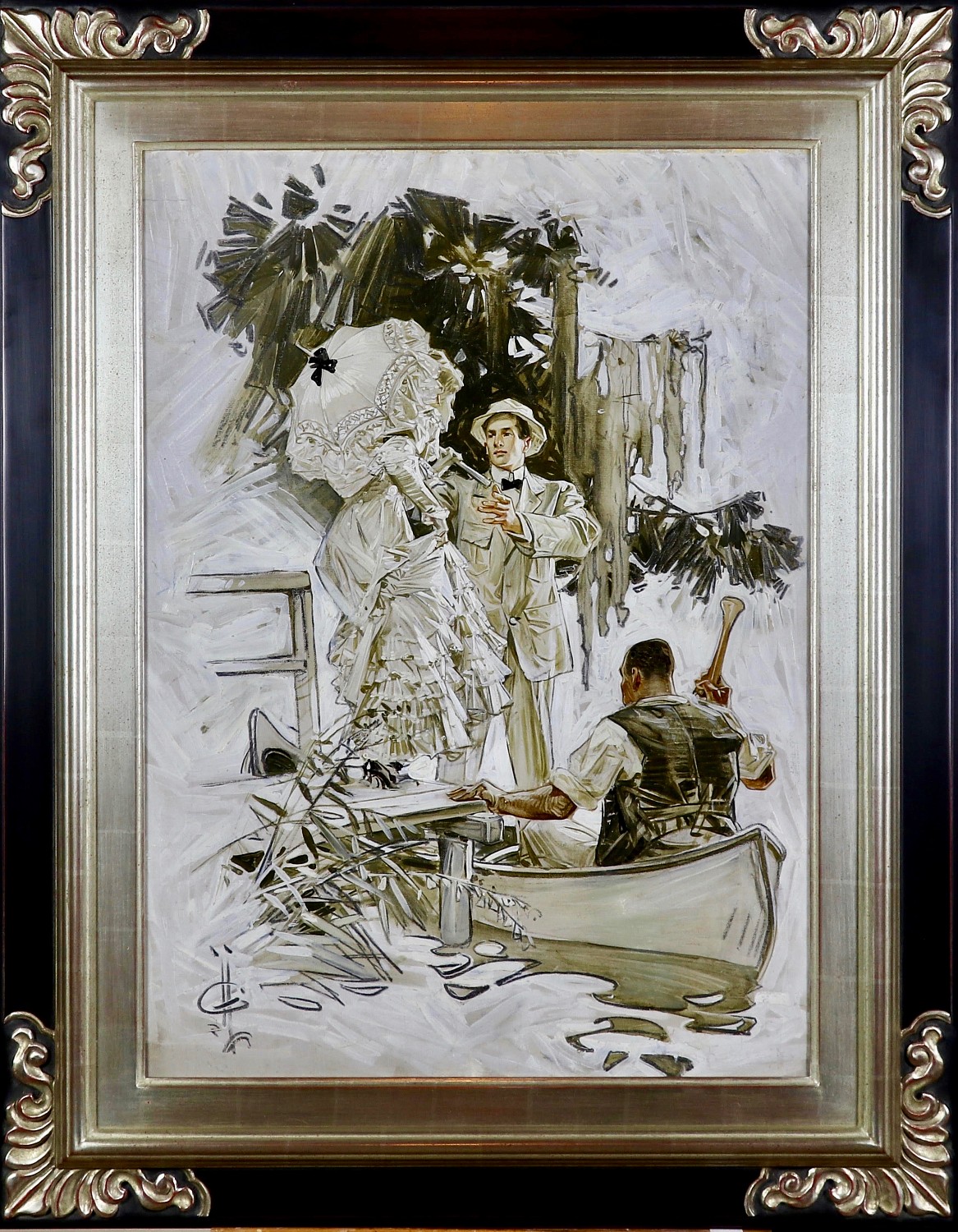"The Voice in the Rice" Lot no. 4095
By Joseph Christian Leyendecker (1874-1951)
29.00" x 21.00"
Oil on Canvas
Signed Lower Left
REQUEST PRICE
PURCHASE REQUEST
EXHIBITED:
Union League Club, Chicago, Illinois, "An American Vision," December 1-2, 1984;
American Illustrators Gallery/ Judy Goffman Fine Art, "J.C. Leyendecker: An Age of Elegance," New York, 1989;
Norman Rockwell Museum, Stockbridge, Massachusetts, "J.C. Leyendecker -- A Retrospective," November 8, 1997-May 25, 1998;
Museum of American Illustrators at Society of Illustrators, New York, "Americans Abroad," May 21-July 12, 2008.
LITERATURE:
G. Morris, "Voice in the Rice," Saturday Evening Post, June 1909;
Curtis Publishing Co., Reflections of a Decade -- 1901-1910, Indianapolis, Indiana, 1980, p. 111, illustrated;
Union League Club, An American Vision, exhibition catalogue, Chicago, Illinois, 1984, p. 8, no. 15, illustrated;
A. Carter, Americans Abroad, exhibition catalogue, New York, 2008, n.p., no. 27, illustrated;
L. Cutler and J. Cutler, J.C. Leyendecker: American Imagist, New York, 2008, p. 217, illustrated.
In the 1890s and early 1900s, as J.C. Leyendecker was developing his pictorial work for advertisements, magazine covers, and posters, he also illustrated a number of novels to supplement his income. These titles include One Fair Daughter (1895), Ships that Pass in the Night (1898), The Kiss of Glory (1902), Ridolfo (1906), The Crimson Conquest (1907), Get Rich Quick Wallingford (1908), The Voice in the Rice (1910) and The Lonely Guard (1912).
The present work is one of six Leyendecker illustrations from Gouverner Morris' The Voice in the Rice, published in book form in 1911. The novel centers on a dashing young man, Michael Bourne, who, after surviving a shipwreck off the coast of South Carolina, washes ashore near the Santee River and encounters a secret slaveholding community. Lord Nairn, a wheelchair-bound tyrant with hypnotic powers, governs this supposedly utopian society, and he soon feels threatened by Michael when they begin to compete for the affections of Mary Moore. Michael can never quite meet Mary in person, but instead hears her melodious voice drifting through the rice swamps (hence the book's title).
Exhibiting Leyendecker's quick brushwork and penchant for the idealized figure, Voice in the Rice depicts the moment that a guest arrives to socialize with Michael and the other young people in this mysterious community:
"At the landing a very beautiful girl, dressed for tennis, was stepping out of a canoe. Her paddler, a short negro of great power, surly and taciturn-looking, backed his canoe and shot off in the rice. I was presented to Miss Stevens of the Heronry. She seemed to have less eyes than the rest, and to express herself with more sense and less banter. . . . She looked at me with steady blue eyes, . . . [and] I thought to myself, 'That is the way Mary Moore would look at one, only not so much so.' [I] strolled part way back to the court with her, and it was arranged that she should take tea with Lady Moore that afternoon, and that, if I felt very strong and careful, I should take her canoeing in the cool" (G. Morris, The Voice in the Rice, New York, 1911, pp. 55-56).
Explore related art collections: $100,000 & Above / Magazine Stories
See all original artwork by Joseph Christian Leyendecker
ABOUT THE ARTIST
Joseph Christian Leyendecker was born in Montabaur, Germany, and came to America at the age of eight. Showing an early interest in painting, he got his first job at 16 in a Chicago engraving house on the strength of some larger pictures he had painted on kitchen oilcloth. In the evenings after work, he studied under Vanderpoel at the Chicago Art Institute, and saved for five years to be able to go to France and attend the Academie Julian in Paris.
Upon his return, as a thoroughly trained artist with immense technical facility, Leyendecker had no difficulty in obtaining top commissions for advertising illustrations and cover designs for the leading publications. His first Post cover was done in 1899, and he did well over 300 more during the next 40 years. Among the most famous of these was his annual New Years Baby series.
His advertising illustrations made his clients famous. The Arrow Collar Man was a byword for the debonair, handsome male, and women wrote thousands of love letters to him in care of Cluett Peabody & Company. His illustrations for Kuppenheimer Clothes were equally successful in promoting an image of suited elegance. He was elected to the Society of Illustrators Hall of Fame in 1977.A major retrospective exhibition of Leyendecker's work was mounted at the Norman Rockwell Museum in Stockbridge, Massachusetts, in 1997-98.
Joseph Christian Leyendecker was born in Montabaur, Germany, and came to America at the age of eight. Showing an early interest in painting, he got his first job at 16 in a Chicago engraving house on the strength of some larger pictures he had painted on kitchen oilcloth. In the evenings after work, he studied under Vanderpoel at the Chicago Art Institute, and saved for five years to be able to go to France and attend the Academie Julian in Paris.
Upon his return, as a thoroughly trained artist with immense technical facility, Leyendecker had no difficulty in obtaining top commissions for advertising illustrations and cover designs for the leading publications. His first Post cover was done in 1899, and he did well over 300 more during the next 40 years. Among the most famous of these was his annual New Years Baby series.
His advertising illustrations made his clients famous. The Arrow Collar Man was a byword for the debonair, handsome male, and women wrote thousands of love letters to him in care of Cluett Peabody & Company. His illustrations for Kuppenheimer Clothes were equally successful in promoting an image of suited elegance. He was elected to the Society of Illustrators Hall of Fame in 1977.A major retrospective exhibition of Leyendecker's work was mounted at the Norman Rockwell Museum in Stockbridge, Massachusetts, in 1997-98.
Kent Steine



